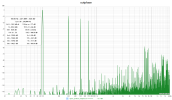Examples wanted - OK. This is my favourite example. The two signals below have identical power spectrum (and rms level).


They differ in phase.


However, for an experienced listener it is easy to tell the sound difference:
The files available for testing are attached below in the in_out_phase.zip file. The 2nd zip file contains both files under test in a row in just one file. The change of perceived pitch can be heard when 1st file transits to the 2nd one, though both signals have the same amplitude spectrum and differ only in phase of the 3rd harmonic component.


They differ in phase.
However, for an experienced listener it is easy to tell the sound difference:
Code:
foo_abx 2.1 report
foobar2000 v2.0
2024-10-31 10:40:30
File A: square_synthesis_inphase.wav
SHA1: cec3a421fcf9bef67e74eef93e8fb81214c8e7d7
File B: square_synthesis_outphase.wav
SHA1: cbe2d8726400680b07414f4533da86ca60f81f67
Output:
WASAPI (shared) : Speaker (USB Sound Blaster HD)
Crossfading: NO
10:40:30 : Test started.
10:41:18 : 01/01
10:41:34 : 02/02
10:41:47 : 03/03
10:41:59 : 04/04
10:42:14 : 05/05
10:42:24 : 06/06
10:42:34 : 07/07
10:42:42 : 08/08
10:42:52 : 09/09
10:43:02 : 10/10
10:43:11 : 11/11
10:43:21 : 12/12
10:43:31 : 13/13
10:43:38 : 14/14
10:43:51 : 15/15
10:44:01 : 16/16
10:44:01 : Test finished.
----------
Total: 16/16
p-value: 0 (0%)
-- signature --
64599d6e0d6df791ef1e90ba7f69d7515cb0f662The files available for testing are attached below in the in_out_phase.zip file. The 2nd zip file contains both files under test in a row in just one file. The change of perceived pitch can be heard when 1st file transits to the 2nd one, though both signals have the same amplitude spectrum and differ only in phase of the 3rd harmonic component.
Attachments
Last edited:

